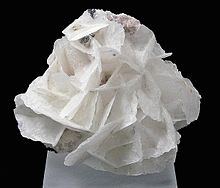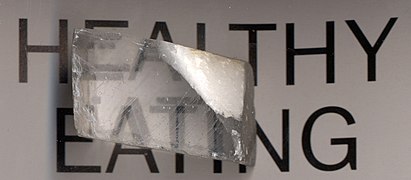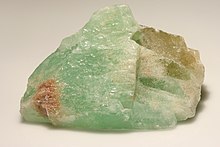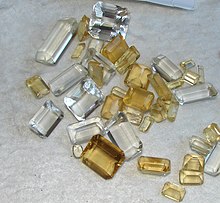Calcite
| Calcite | |
|---|---|
| Almost colorless calcite scalenohedron with shiny glass surfaces from the Jiepaiyu Mine, Shimen , Changde Prefecture, Hunan, China (size 6.1 cm × 5.4 cm × 3.2 cm) | |
| General and classification | |
| other names |
|
| chemical formula | Ca [CO 3 ] |
|
Mineral class (and possibly department) |
Carbonates and nitrates - anhydrous carbonates without foreign anions |
|
System no. to Strunz and to Dana |
5.AB.05 ( 8th edition : Vb / A.02) 01/14/01/01 |
| Similar minerals | Aragonite , dolomite |
| Crystallographic Data | |
| Crystal system | trigonal |
| Crystal class ; symbol | ditrigonal-scalenohedral; 3 2 / m |
| Space group | R 3 c (No. 167) |
| Lattice parameters | a = 4.99 Å ; c = 17.06 Å |
| Formula units | Z = 6 |
| Frequent crystal faces | {10 1 0}, {0001}, {01 1 2}, {02 2 1} |
| Twinning | (0001), very often sliding twins (polysynthetic translational lamellae) according to (01 1 2) |
| Physical Properties | |
| Mohs hardness | 3 |
| Density (g / cm 3 ) | 2.6 to 2.8; pure 2.715 |
| Cleavage | very perfect after (10 1 1) gap angle 75 ° |
| Break ; Tenacity | shell-like, brittle |
| colour | mostly colorless, milky white, gray, yellow, pink, red, blue, green, brown to black |
| Line color | White |
| transparency | transparent to opaque |
| shine | Glass gloss, also mother-of-pearl |
| Crystal optics | |
| Refractive indices |
n ω at ~ 590 nm: 1.640 to 1.660; pure 1.658 (In the range from 190 to 1700 nm, n ω falls from about 1.6 to about 1.4.) n ε at ~ 590 nm: 1.486 In the range from 190 to 1700 nm, n ε falls from about 1.9 to about 1.5. |
| Birefringence | δ = 0.154 to 0.174; pure 0.172 |
| Optical character | uniaxial negative |
| Axis angle | 2V = can occur abnormally biaxially 2V x then 4–14 ° (up to 25 °) |
| Pleochroism | unavailable |
| Other properties | |
| Chemical behavior | soluble in cold, dilute acids with a violent shower |
| Special features | very strong birefringence; occasionally fluorescence in red or orange; frequent twin lamellae |
Calcite , calcite , calcite or double spar , is a very common mineral from the mineral class of " carbonates and nitrates" with the chemical composition Ca [CO 3 ] and thus, from a chemical point of view, calcium carbonate .
Calcite crystallizes in the trigonal crystal system and develops different crystal or aggregate forms ( habit ). In its pure form, calcite is colorless and transparent. However, due to multiple refraction due to lattice construction defects or polycrystalline training, it can also appear white, with the transparency decreasing accordingly, and due to foreign admixtures it can take on a yellow, pink, red, blue, green, brown or black color.
With a Mohs hardness of 3, calcite is one of the medium-hard minerals, which means that it can be scratched with a copper coin. It serves as a reference value on the Friedrich Mohs scale, which goes up to 10 ( diamond ) .
Etymology and history
Calcite in the form of limestone was already known in ancient times and was called χάλιξ chálix in ancient Greece, meaning “small stone” or “gravel”, but also lime or limestone. The term calx used in the Roman Empire is regarded as a loan word from the Greek, but only stands for raw and slaked lime that served as mortar . The limestone used as a building material was assigned to the marble.
The name calcite (originally calcite ) for the mineral, which is still valid today, was coined in 1845 by Wilhelm von Haidinger , who objected to the superordinate name for all of its forms of formation (limestone, calcite, double spar, moon milk, etc.), which had been missing until then. He was based on the superordinate designation Calcaire by Delamétherie and Beudant , which, however, remained limited to the French language.
The property of calcite of being able to crystallize in all forms and combinations of the rhombohedral system was of importance for the derivation of the laws of crystallography which should not be underestimated. The English doctor William Pryce had foreseen the fundamentals of crystallography as early as 1778 when he found in the Mineralogia Cornubiensis that all forms of calcite result from the basic form of the rhombohedron by simple splitting . The French mineralogist René-Just Haüy (1743–1822) developed the first, practically usable crystallography on this basis. As is so often the case, there is also a legend surrounding Haüy's discovery. Haüy fell a large calcite crystal from the table to the floor and shattered into many pieces. As he picked up the fragments, Haüy noticed that although they all had a different shape, they all resembled the rhombohedral Iceland spar. Haüy repeated the process with the different crystal forms of the calcite and each time he received a rhombohedron. From this observation he concluded that the crystals arise from the repetition of the elementary lattice or the unit cell in the three spatial directions. He recorded his observations in the years 1781 and 1782 in his book Memoire sur la structure des crystaux . This was the first time that the basic laws of crystallography were formulated and explained using the example of calcite.
classification
In the outdated 8th edition of the mineral classification according to Strunz , calcite belonged to the common mineral class of "carbonates, nitrates and borates" and there to the department of "anhydrous carbonates without foreign anions ", where it was named the "calcite group" with the systemic mineral No. Vb / A.02 and the other members gaspéit , magnesite , otavite , rhodochrosite , siderite , smithsonite and spherocobaltite .
In the last revised and updated Lapis mineral directory by Stefan Weiß in 2018 , which, out of consideration for private collectors and institutional collections, is still based on this classic system of Karl Hugo Strunz , the mineral was given the system and mineral number. V / B.02-20 . Also in the “Lapis system” this corresponds to the section “Anhydrous carbonates [CO 3 ] 2- , without foreign anions”, where calcite also gives its name to the “calcite group” with the other members gaspéit, magnesite, otavite, rhodochrosite, siderite, smithsonite , Spherocobaltite and vaterite .
The 9th edition of Strunz's mineral systematics , valid since 2001 and updated by the International Mineralogical Association (IMA) until 2009, assigns calcite to the newly defined class of "carbonates and nitrates" (the borates now form a separate class), but there also in the section of “carbonates without additional anions; without H 2 O “. This is, however, further subdivided according to the group affiliation of the cations involved , so that the mineral can be found according to its composition in the subsection " alkaline earth (and other M 2+ ) carbonates", where it is the still existing "calcite group" with the System no. 5.AB.05 forms. Vaterite now forms its own group.
The systematics of minerals according to Dana , which is mainly used in the English-speaking world , assigns calcite, like the outdated Strunz system, to the common class of “carbonates, nitrates and borates” and there to the department of “anhydrous carbonates”. Here, too, as the namesake of the "Calcite group (Trigonal: R 3 c )" with the system no. 01/14/01 to be found in subdivision 14.01 anhydrous carbonates with simple formula A + CO 3 .
Crystal structure
Calcite crystallizes trigonal in the space group R 3 c (space group no. 167) with the lattice parameters a = 4.99 Å and c = 17.06 Å as well as 6 formula units per unit cell .
The crystal structure consists of a built-up along the c-axis [0001], sheet-like array of planar CO 3 groups, and corner-sharing calcium - octahedra . Each oxygen ion of the CO 3 group is connected to a calcium ion each of the layer below and the layer above and thus forms a 3-dimensional network.
properties
Physical Properties
A particularly high level of birefringence is characteristic of calcite crystals . Light that is not incident along the optical axis of the crystal is split into two bundles of light, an ordinary and an extraordinary ray. Different refractive indices apply to these two beams due to different polarization directions . This is shown by the fact that every object observed through a clear crystal appears twice at a certain angle, a very helpful property for identifying calcite, hence the common name double spar . In Iceland , the most famous occurrence of double spar, it is called silfurberg ( silver rock ).
The theoretical density of the calcite is 2.71 g / cm³. However, the effective density varies between 2.6 and 2.8 g / cm³, depending on how many calcium ions in the crystal lattice are replaced by other metal ions such as iron, manganese or zinc.
Depending on where it was found, calcite can fluoresce red, blue or yellow, but also in other colors , due to the storage of rare earths under UV light . Furthermore, come phosphorescent , carthodolumines- , thermo and rarely tribolumineszierende before Calcite.
Illustration of the high birefringence of a large calcite single crystal ("double spar") by doubling the writing below ...
Chemical properties
Compared to other minerals, calcite is hardly resistant to weathering . It is much softer than quartz or feldspar and is already soluble in acidic water. In cold, dilute acids , calcite dissolves with violent evolution of gas.
colour
Pure calcite is transparent and colorless. However, it is rarely found in nature. Apart from the Icelandic spar, natural calcite is usually honey-yellow to yellow-brown in color, massive varieties are milky white. The different colors of calcite arise when ions of other metals such as iron, zinc, cobalt or manganese replace the calcium ions in the crystal lattice. Iron gives a yellow-brown hue, zinc leads to a grayish-white hue, cobalt gives pink hues and manganese finally gives mauve or violet hues. In addition, varieties containing manganese are often carmine-red fluorescent. If a small amount of malachite is added to the calcite, it can even take on a green color, as can be seen in the secondary calcite veins of the limestone massif of Vizarron in central Mexico. These, like all the other colors mentioned above, often highlight individual growth zones of the calcite crystals and can be observed quite frequently. The sky blue to lavender blue calcite is exceptional, the color of which is due to imperfections in the crystal lattice caused by radiation from radioactive minerals. The blue hue weakens over time and disappears completely after a few months when the crystals are exposed to the sun.
Modifications and varieties


Calcium carbonate is trimorphic and occurs naturally in addition to the trigonal crystallizing calcite as orthorhombically crystallizing aragonite and hexagonally crystallizing vaterite .
Anthracolite or also anthraconite is the name for a black, carbon-rich to bituminous variety of calcite.
The variety Atlasspat (also Seidenspat or English Satin Spar ) consists of fine-grain calcite with a silk-like sheen on the surfaces. The use of the name Atlasspat is, however, inconsistent and is also used for fine-fiber plaster of paris with a silk gloss.
As Blätterspat or Papierspat Calcitvarietäten are denoted by thin, sheet-like crystals.
Calcites that are yellow-brown to orange in color due to the storage of iron ions are called honey calcite or orange calcite .
Kanonenspat is a calcite variety with a long, elongated, pseudo-hexagonal habit.
As Kobaltocalcit (also Cobaltocalcit ) are determined by the addition of cobalt referred pink to pink-colored varieties. Calcites are also known to have a pale pink color due to the addition of manganese .
A pseudomorphism from calcite to Ikait is known as glendonite .
Education and Locations


Calcite is formed according to the chemical equilibrium :
The equilibrium of the above reaction shifts increasingly to the right side with increasing temperature. In warm waters, living things can form lime casings with less energy. In steam boilers and other vessels in which calcareous water is heated, scale is created in this way .
Calcite can be massive as well as granular , fibrous or in crystals and in the latter case shows the greatest wealth of forms of all minerals. As a rock- forming mineral, it is one of the most common minerals in the earth's crust and occurs both in igneous rocks , for example in carbonatites , in metamorphic ( marble ) or sedimentary rocks such as limestone . It occurs alone or in association with other minerals in corridors , but also occurs on the surface of the earth. Calcite was often formed through biomineralization, be it in rock formations, in the soil, as partially undesirable plaque (in addition to preferably calcium hydroxylapatite) etc .; but here always in very specific micro-environmental conditions.
Calcite dissolves well in acidic water and is easily leached out of limestone, creating cave systems. The dissolved calcite is deposited elsewhere. This creates the typical stalactites , stalagmites and stalactites .
By far the largest deposits of calcite can be traced back to marine deposits . The calcite-containing skeletons and shells of countless small marine animals such as mussels , corals and various protists such as the coccolithophores settle on the seabed. These calcareous algae are smaller than 30 micrometers and are counted among the nanoplankton . They form tiny calcareous shields, the so-called coccoliths , which sink to the ocean floor after the algae die. The chalk cliffs of Dover are made up of such coccoliths. Even coral reefs play a prominent role in the calcite.
Inorganic, abiogenic formation areas of calcite are flat, in the inter tidal , tropical sea platforms. There, calcite is precipitated in the form of millimeter-sized spheres (Kalkooiden). Calcite in marble goes back to thermal metamorphosis of calcite sediments.
From a sea depth of 3500 meters, the so-called calcite compensation depth , calcite dissolves completely in water. Therefore, at this depth, neither calcite sediments nor mussel shells or skeletons are preserved.
Calcite occurs as a deposit in the statolith membrane of the macular organs of the inner ear . There it plays a major role in the perception of accelerations and the direction of the perpendicular .
Iceland is best known for its extraordinary calcite finds, where the largest crystals so far have been found in addition to the clear double spar . At Helgustadir near Reyðarfjörður , the largest crystal was 7 m × 7 m × 2 m and the heaviest had a weight of 280 t. A calcite rhombohedron measuring 109 cm × 95 cm × 46 cm and weighing around 500 kg was found in the "Sterling Bush" cave in Lewis County (New York) .
One of the largest calcites on display in museums, weighing 230 kg, is in the Natural History Museum in London.
use
Building material and raw material
The calcite-containing rocks marble , limestone and onyx marble are a high-quality decoration and building material. Calcite in limestone is also used for the production of cement and artificial fertilizers and as an additive in the smelting of ores . Because of their optical properties, particularly pure crystals are used in the optical industry , in particular in polarization optics , for example in the form of Glan-Taylor prisms or as retardation plates. It is also used in acidic, rutile-coated and basic electrodes as a protective gas generator in manual arc welding.
Gemstone
Calcite is actually too soft for commercial gemstone production and, due to its perfect cleavage, also too sensitive. Occasionally, however, it is offered in a smooth cut as a cabochon or tumbled stone. Experienced collectors also succeed in shaping calcite into facets .
Terrarium substrate
Ground calcite or limestone is sold as "calcium sand" in different fine grain sizes under various brand names as a substrate for terrariums . The basic idea is that "calcium sand" does not lead to clogging due to its acid solubility after ingestion by terrarium animals, in contrast to conventional acid-insoluble quartz sand . However, "calcium sand" is also said to lead to clumps in the gastrointestinal tract and thus to severe constipation, which can only be treated surgically. Eyelids and lips can also stick together quickly. The assumed main cause of ingestion of terrarium substrates is an undersupply of the animals with calcium. Due to the generally negative consequences of substrate intake, this should not be counteracted by using "calcium sand", but by offering sepia pulp and enriching the feed with calcium-containing food supplements.
Double spar was possibly used by the Vikings as a navigation aid during their journeys . Due to its birefringent properties, when the sun is viewed through such a crystal, two bundles of light are created, the intensity of which depends on the angle of incidence of the sunlight. If both light bundles are identical in their intensity, the crystal is aligned to the sun. In an experiment, researchers found that this works reliably even when it is cloudy and even up to 40 minutes after sunset.
See also
literature
- Johann Carl Free Life : Calcite . In: Magazine for the oryctography of Saxony . tape 7 , 1836, pp. 118–121 ( rruff.info [PDF; 338 kB ; accessed on November 18, 2019]).
- Helmut Schrätze , Karl-Ludwig Weiner : Mineralogy. A textbook on a systematic basis . de Gruyter, Berlin; New York 1981, ISBN 3-11-006823-0 , pp. 503-515 .
Web links
- Mineral Atlas: Calcite and Mineral Portrait Calcite (Wiki)
- Calcite. In: mindat.org. Hudson Institute of Mineralogy, accessed November 18, 2019 .
- David Barthelmy: Calcite Mineral Data. In: webmineral.com. Retrieved November 18, 2019 .
- Calcite search results. In: rruff.info. Database of Raman spectroscopy, X-ray diffraction and chemistry of minerals (RRUFF), accessed on November 18, 2019 .
Individual evidence
- ↑ a b c d Hugo Strunz , Ernest H. Nickel : Strunz Mineralogical Tables. Chemical-structural Mineral Classification System . 9th edition. E. Schweizerbart'sche Verlagbuchhandlung (Nägele and Obermiller), Stuttgart 2001, ISBN 3-510-65188-X , p. 286 (English).
- ↑ a b c d Wolfgang F. Tegethoff: Calcium carbonate. From the Cretaceous into the 21st century . Springer-Verlag, 2013, ISBN 978-3-0348-8259-0 , pp. 10 ( limited preview in Google Book search).
- ^ Daniel W. Thompson, Michael J. De Vries, Thomas E. Tiwald, John A. Woollam: Determination of optical anisotropy in calcite from ultraviolet to mid-infrared by generalized ellipsometry . In: Thin Solid Films . tape 313-314 , 1998, pp. 341-346 , doi : 10.1016 / S0040-6090 (97) 00843-2 (English).
- ↑ a b Hans Lüschen: The names of the stones. The mineral kingdom in the mirror of language . 2nd Edition. Ott Verlag, Thun 1979, ISBN 3-7225-6265-1 , p. 246 .
- ^ Wilhelm von Haidinger: Handbook of determining mineralogy: containing the terminology, systematics, nomenclature and characteristics of the natural history of the mineral kingdom . Braumüller & Seidel, Vienna 1845, p. 464–465 ( reader.digitale-sammlungen.de [accessed on November 18, 2019]).
- ↑ a b Stefan Weiß: The large Lapis mineral directory. All minerals from A - Z and their properties. Status 03/2018 . 7th, completely revised and supplemented edition. Weise, Munich 2018, ISBN 978-3-921656-83-9 .
- ↑ Ernest H. Nickel, Monte C. Nichols: IMA / CNMNC List of Minerals 2009. (PDF 1703 kB) In: cnmnc.main.jp. IMA / CNMNC, January 2009, accessed November 18, 2019 .
- ↑ Hans Jürgen Rösler : Textbook of Mineralogy . 4th revised and expanded edition. German publishing house for basic industry (VEB), Leipzig 1987, ISBN 3-342-00288-3 , p. 695 .
- ^ Calcite . In: John W. Anthony, Richard A. Bideaux, Kenneth W. Bladh, Monte C. Nichols (Eds.): Handbook of Mineralogy, Mineralogical Society of America . 2001 (English, handbookofmineralogy.org [PDF; 68 kB ; accessed on November 18, 2019]).
- ↑ Anthracolite. In: Mineralienatlas Lexikon. Stefan Schorn u. a., accessed on November 18, 2019 .
- ↑ Richard V. Gaines, H. Catherine W. Skinner, Eugene E. Foord, Brian Mason , Abraham Rosenzweig: Dana's New Mineralogy . 8th edition. John Wiley & Sons, New York et al. 1997, ISBN 0-471-19310-0 , pp. 428 .
- ↑ Calcite Satin Spar (short Satin Spar ). In: mindat.org. Hudson Institute of Mineralogy, accessed on November 18, 2019 (English, German synonyms Atlasspat and Atlasspath ).
- ↑ Ulrich Henn: Gemstone Dictionary . Ed .: German Gemmological Society. Self-published, Idar-Oberstein 2001, ISBN 3-932515-24-2 , p. 10 .
- ↑ a b Name search, trade names and what they mean. EPI - Institute for Gemstone Testing, accessed on November 18, 2019 (entry of the corresponding variety or trade name required).
- ↑ cannon spar. In: Mineralienatlas Lexikon. Stefan Schorn u. a., accessed on November 18, 2019 .
- ↑ cobalt calcite. In: Mineralienatlas Lexikon. Stefan Schorn u. a., accessed on November 18, 2019 . and manganese localcite. In: Mineralienatlas Lexikon. Stefan Schorn u. a., accessed on November 18, 2019 .
- ↑ Karl-Erich Schmittner, Pierre Giresse: Micro-environmental controls on biomineralization: superficial processes of apatite and calcite precipitation in Quaternary soils, Roussillon, France . In: Sedimentology . tape 46 , no. 3 , 1999, p. 463-476 , doi : 10.1046 / j.1365-3091.1999.00224.x (English).
- ↑ Mineral records. In: Mineralienatlas Lexikon. Stefan Schorn u. a., accessed on November 18, 2019 .
- ^ Charles Palache : The largest crystal. In: minsocam.org. American Mineralogist, accessed November 18, 2019 (originally published in: American Mineralogist. Volume 17, 1932, pp. 362-363).
- ^ Krassmann: Giant Iceland Spar from Helgustadir, Iceland. In: mineral-exploration.de. February 28, 2018, accessed April 3, 2018 .
- ^ Walter Schumann: Precious stones and gemstones. All kinds and varieties. 1900 unique pieces . 16th, revised edition. BLV Verlag, Munich 2014, ISBN 978-3-8354-1171-5 , pp. 224 .
- ↑ Michael RW Peters: Calcite (with picture examples of cut calcite). In: realgems.org. July 24, 2011, accessed November 18, 2019 .
- ↑ Vikings used transparent mineral as a solar compass. In: scinexx.de. scinexx das wissensmagazin, November 2, 2011, accessed on November 18, 2019 .
- ↑ Guy Ropars, Gabriel Gorre1, Albert Le Floch, Jay Enoch, Vasudevan Lakshminarayanan: A depolarizer as a possible precise sunstone for Viking navigation by polarized skylight . In: Proceedings of the Royal Society A . 2011, doi : 10.1098 / rspa.2011.0369 .
- ^ Albert Le Floch, Guy Ropars, Jacques Lucas, Steve Wright, Trevor Davenport, Michael Corfield, Michael Harrisson: The sixteenth century Alderney crystal: a calcite as an efficient reference optical compass? In: Proceedings of the Royal Society A . tape 469 , no. 2153 , 2013, doi : 10.1098 / rspa.2012.0651 .








